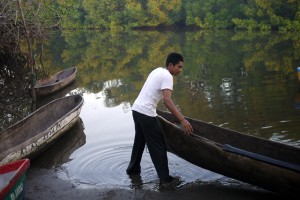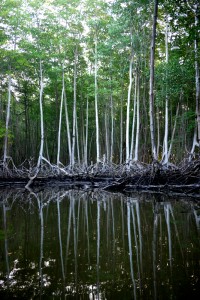EL ESPINO–It was still midnight dark when I woke. I checked my watch, 0500, plenty of time until I had arranged to meet Francisco. I showered and dressed, checked my cameras and slipped into the courtyard of Hotel Delfin Dorado, The Golden Dolphin. The watchman heard my door close and woke from his hammock. I explained I was meeting someone and he grunted and shuffled to unlock the small port in the iron gates. I had a half hour and sat in one of the beach chairs and looked at the black sky, trying to discern some trace of dawn.
Madrugada: my favorite Spanish word. “Madrugada,” I said to myself, rolling the syllables there in the dark. It means that indeterminate time of morning, after midnight certainly, before dawn when it is not night but the world is different. Madrugada.
My reverie was interrupted as I saw another form come out of the darkness. It was Katie Jackson, a Youth Minister from New Bremen, Ohio, here with the SARA group on her first trip out of the United States. “Good morning,” she whispered, “I hope I’m not bothering you. I thought I’d get up to photograph the sunrise.”
“No, you aren’t bothering me, sit down.”
We talked a while, quietly, of travel and life and her trip so far as the sky gradually became gray. I explained to her why I was up but she later confessed she hadn’t quite understood what I was up to.
Franciso arrived as the sky just began to lighten into colors and asked if we were ready, apologized for not having any transportation and so we began to walk, Katie following along. Franciso is the 25-year-old leader of a local youth group that works with the currileros, the children of the Pacific mangrove coast who dig clams from the tidal mud. It helps to feed and provide some money for their families and is the first step in their apprenticeship as fishermen and fishermen’s wives. He grew up in that timeless life but has also become active in his community, working with the Salvadoran and US NGOs like SARA that have projects in the area to provide better education, health-care and services.
The day before I had arranged with him to take me out on the river at sunrise in a small boat, to see the mangroves from that quiet perspective and, hopefully, to see some of the crocodiles they mention every now and then.
We walked down the dusty road, then turned off on a path through the scrub and finally ended up at a house by the river where several boats and dugout canoes of different sizes were pulled onto the muddy bank. To my pleasant surprise I realized it was a place I had photographed from the river in the past. He spoke briefly to a woman cooking breakfast on an open fire. We said good morning and then were climbing into an old dugout, much painted and patched with fiberglass and then were gliding out onto the mirror-smooth river.
The sun was now just up over our shoulders and the glassy river reflected the tangled mangrove roots and tall trees forming a double image of everything on shore. Every time in the past I had been out on the river, the Rio Bahia de Jiquilisco, in a motor launch with a crowd of children on their way out to work. I had always envied the silent canoes we passed and was determined for once to go out in one of them.
I sat in the prow and Francisco paddled from the stern. Behind me, in a small voice, I heard Katie whisper, “I think this is the strangest thing I have ever done.” I smiled and thought that it wasn’t quite a normal day for me either but also how strange that I have been on this river, unknown to most Americans and probably to most Salvadorans, six or seven times.
We turned down a channel in the mangroves where I had been before and then into a much narrower one. We paddled in silence until Franciso said, “This is where the crocodiles often are, though it is best to be here in the night.”
The channel kept narrowing and we passed under hanging roots like green snakes. Katie told me a small crab had jumped off onto my arm. I assured her it was harmless and that I’d have a crab any day next to a snake or bug. “I don’t mind bugs,” she said. “I do,” I replied.
Finally the channel narrowed to a close with nary a crocodile heaving into view. Franciso expertly spun the heavy canoe around and we began our journey out. The morning had become blazingly hot. I thought we were now just on our way back but Franciso made another turn and before us was a high bank. He ran the canoe onto the narrow beach and we disembarked. He motioned to climb the steep trail and when we reached the top, twenty or thirty feet above the river we found ourselves on a long ridge, an island surrounded by the impenetrable green of the forest.
We walked down a trail through the stumps of a harvested maize field and the Francisco pointed out a slightly raised hump of lighter earth. I looked closer and realized it was hundreds of thousands of clam shell fragments. “The Indians,” said, Franciso, “The Pipil Indians who were here after the Maya, this is where they threw the shells.”
It was a midden, or dump, an ancient landfill if you will where the Indians threw the remains of their dinner. “We find artifacts here,” he said, “clay dolls and grinding stones,” then, “We think, farther on, there was once a pyramid. We have looked at the pyramids at San Andreas and other places and it is very similar land.” He paused, “There is much here if you walk on the land. When you walk you see more. Also,” he paused, “There is an enormous rock deep in the mangroves where there are no other rocks.”
I looked at my watch and knew we had to be back, that unless turned around now we would upset the day’s schedule. The mysteries stayed, as they usually do, just out-of-reach. We turned around and then Francisco bent over and handed me a whole, large clam shell. “It is the kind we call the Casco de Burro.”
I held the object and rubbed some of the dirt from its old and weathered ridges. I turned it over in my hand and remembered, some years before, a boy pulling one from the mud, showing it to me and remarking excitedly, “Uno Casco!” I thought about the hand that had pulled this one, in exactly the same way, from the mud so many hundreds of years before. I looked with longing down the trail and wondered what else was out there, what secrets the mangroves held, and I returned to the dugout canoe planning how to find out.




Post a Comment